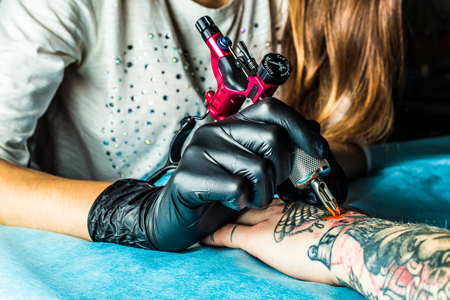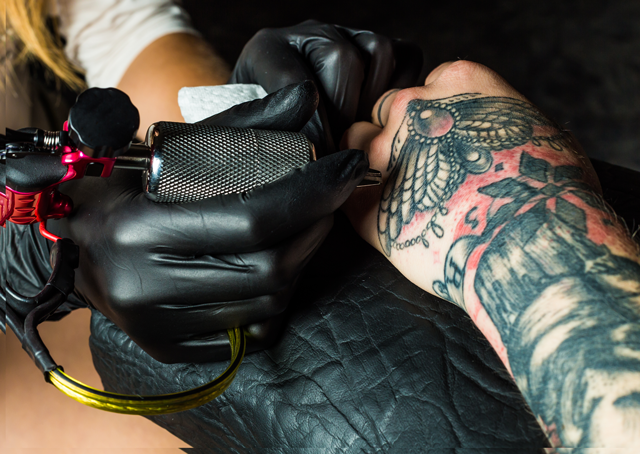Ever Consider Your Tattoo Might Be Toxic?
Tattoos are an ancient art form with origins that trace back as far as the Stone Age (12,000 BCE).
They have remained a popular form of adornment and self-expression throughout time and across many cultures and continents, for teenagers and beyond. [1]
Are Tattoos Toxic?

The notion that tattoos may be toxic is probably one that does not cross most peoples’ minds.
They wouldn’t do it if it was harmful, right?
But if this were true, the world would be a very different place as far as world health is concerned.
The fact is, the inks and pigments used in tattoos are not yet regulated as potentially toxic products by the FDA, and are classified and regulated as cosmetics and color additives.
Permanent tattoos are made by using needles to inject colored ink below the skin’s surface.
Some risks, such as the spread of infection through needles, have long been known.
But what isn’t clear is the safety of tattoo inks, particularly with the growing popularity of coloured inks, which make tattoos these days more spectacular than ever.
So before you go in for permanent body art and have your loved one’s name tattooed right down your arm, it’s a good idea to understand the risks involved.
A recent report from the European Commission’s Joint Research Centre has raised questions about the safety of tattoo inks in Europe and the US.
It revealed that the microscopic nanoparticles found in tattoo inks can readily penetrate your skin and travel to underlying blood vessels and your bloodstream.
These nanoparticles include heavy metals such as arsenic, lead, and nickel, as well as organic compounds, bacteria, and other potentially harmful substances.
Possible Tattoo Side-Effects
Evidence suggests that the dangers of tattoo ink are many, and that they may induce the following effects:
- Infection – Infections like hepatitis and HIV can pass through dirty needles from one person to another.
- Allergies– Allergies to various ink pigments have been reported and can cause problems.
- Scarring – Unwanted scar tissue may form when getting or removing a tattoo.
- Granulomas – These small knots or bumps may form around material that the body perceives as foreign, such as particles of tattoo pigment.
- MRI complications – People may have swelling or burning in the tattoo when they have magnetic resonance imaging (MRI). This happens rarely and does not last long, and is due to degradation of the pigment by the radiation. [2]
Correction: MRI machines do not use radiation to create images, they use magnetism. If there is discomfort in a tattoo while in an MRI machine, it is likely due to the ink being heated rather than being degraded
- The spread of tattoo ink to the body’s lymphatic system. It’s unknown whether this has health consequences. [3]
- Itchiness and inflammation when exposed to summer sunlight, even in older tattoos, due to pigment degradation on UV exposue.
Research also suggests they may cause toxic effects in your brain, nerve damage, genetic mutations, reproductive problems, and some may also be carcinogenic. [4]
These inks are the same ones used in permanent and semi-permanent makeup, and the report has prompted the European Chemicals Health Agency (ECHA) to call for a thorough review and strict regulation of all inks used for these purposes.
The Agency is about to publish a list of suspect chemicals widely used in tattoo inks, which is likely to lead to their being banned across the European Union, with the UK and the US likely to follow suit if this happens. [5]

More on Tattoo Ink
More than 100 colorants and 100 additives are in use.
Most tattoo inks on the EU market are imported from the US.
The pigments used are not specifically produced for tattoo applications and are generally low in purity
Over 80% of the colorants in use are organic and more than 60% of them are azo-pigments, some of which can release carcinogenic aromatic amines.
This degradation may happen in the skin, particularly under solar/Ultra Violet radiation exposure or laser irradiation.
Accurate methods for the analysis of tattoo inks need to be developed before they can be regulated efficiently. [5]
 You Still Want a Tattoo?
You Still Want a Tattoo?
You are not alone.
As the demand for tattoos continues to rise, so has the variety of inks available.
There are many safe tattoo inks that are made with purer ingredients, and manufacturers are willing to tell you exactly what’s in them.
The best non-toxic carriers to look for in ink ingredients are vegetable glycerin, witch hazel, water, or ethanol.
Another way to stay safer is to choose your artists wisely.
Do your research and see what artists are conscious about their inks and willing to talk to you about it.
You can also avoid certain ingredients in ink pigments that are seen to be more dangerous than others.
The safest tattoo inks are the purest ones, and the following list may be of help:
- Red: Red pigment often causes the most skin reactions and is considered the most dangerous because it contains cinnebar, cadmium, mercury, rust or iron oxide. Choose a red ink with naphthol instead.
- Purple and Violet: Choose non-toxic Carbazole or Dioxazine for this pigment, try to avoid manganese violet.
- Yellow: Choose Arylide or Tumeric based pigments.
- Blue and Green: Copper pthalocyanine pigments are the safest choice for both of these. Specifically Monoazo for green and sodium based for blue.
- Black and White: Avoid animal based inks that are often referred to as “India Inks.” The two most popular tattoo inks, white and black pigments, can be used on their own, especially in tribal tattoos and for shading of coloured tattoos. They have long been some of the most toxic ink colours. Black ink has traditionally been made of iron. Non-toxic versions include carbon, logwood and magnetite crystals for black ink, and titanium dioxide for white pigments. [6] [7]
The best way to avoid known carcinogens is to regulate the process yourself and know what you’re putting on your skin.
Until more research has been conducted and these products are properly regulated, the long-term effects of these inks cannot be known with any certainty.
And remember fads come and go, but with this fad it’s permanent.
Maybe I should set up shop as a laser tattoo removalist.
Would you like to find out more?
Until next time
Yours in Health

Disclaimer: The information provided does not take into account individual needs of any particular person. When providing this information it is intended as a sharing of knowledge and information from the research. The information provided should not be construed as personal medical advice or instruction and is not intended to replace a one-on-one relationship with a qualified health care professional and is not intended as medical advice. We encourage you to make your own health care decisions based upon your research and in partnership with a qualified health care professional.
References:
1] emedicine.medscape.com/article/1121212-overview#a1
2] fda.gov/ForConsumers/ConsumerUpdates/ucm048919.htm
3] webmd.com/skin-problems-and-treatments/news/20160826/how-safe-tattoo-ink#1
4] healthimpactnews.com/2015/think-before-you-ink-the-little-known-risks-of-tattoos
5] ec.europa.eu/jrc/en/publication/eur-scientific-and-technical-research-reports/safety-tattoos-and-permanent-make-final-report
6] livestrong.com/article/180816-non-toxic-tattoo-ink-ingredientshttp:
7] nontoxicrevolution.org/your-body/how-toxic-are-tattoos-and-four-other-frequently-asked-questions-about-ink-toxicity/#.WD8e2OZ9600

 You Still Want a Tattoo?
You Still Want a Tattoo?
MORE BLOG STORIES
Breaking Down the B Vitamins
Amazing Ways to Help Heal Mitochondrial Dysfunction!
The 5 Worst Foods For Your Gut
‘THE GOLDEN GODDESS’
Mitochondria, Inflammation and Oxidative Stress
Tired? You May Be Suffering From Mitochondrial Dysfunction